Nursing Communication Skills and Patient-Centered Care: Case Study
VerifiedAdded on 2022/09/17
|5
|1296
|18
Essay
AI Summary
This essay delves into the critical role of effective communication in nursing, using the case of Mr. Chester, a 19-year-old with a history of depression, as a focal point. The essay emphasizes the importance of both verbal and non-verbal communication skills in building therapeutic relationships, understanding patient needs, and fostering trust, particularly in addressing Mr. Chester's feelings of loneliness and depression. It highlights the significance of patient-centered care, encouraging patient participation in care plans, and educating patients about healthy lifestyle choices, including quitting smoking and alcohol consumption. Furthermore, the essay stresses the importance of accurate and professional nursing documentation as legal evidence and a basis for creating patient-centered care plans, ensuring the delivery of high-quality patient care. The analysis underscores the interconnectedness of effective communication, patient-centered care, and precise documentation in achieving positive patient outcomes.
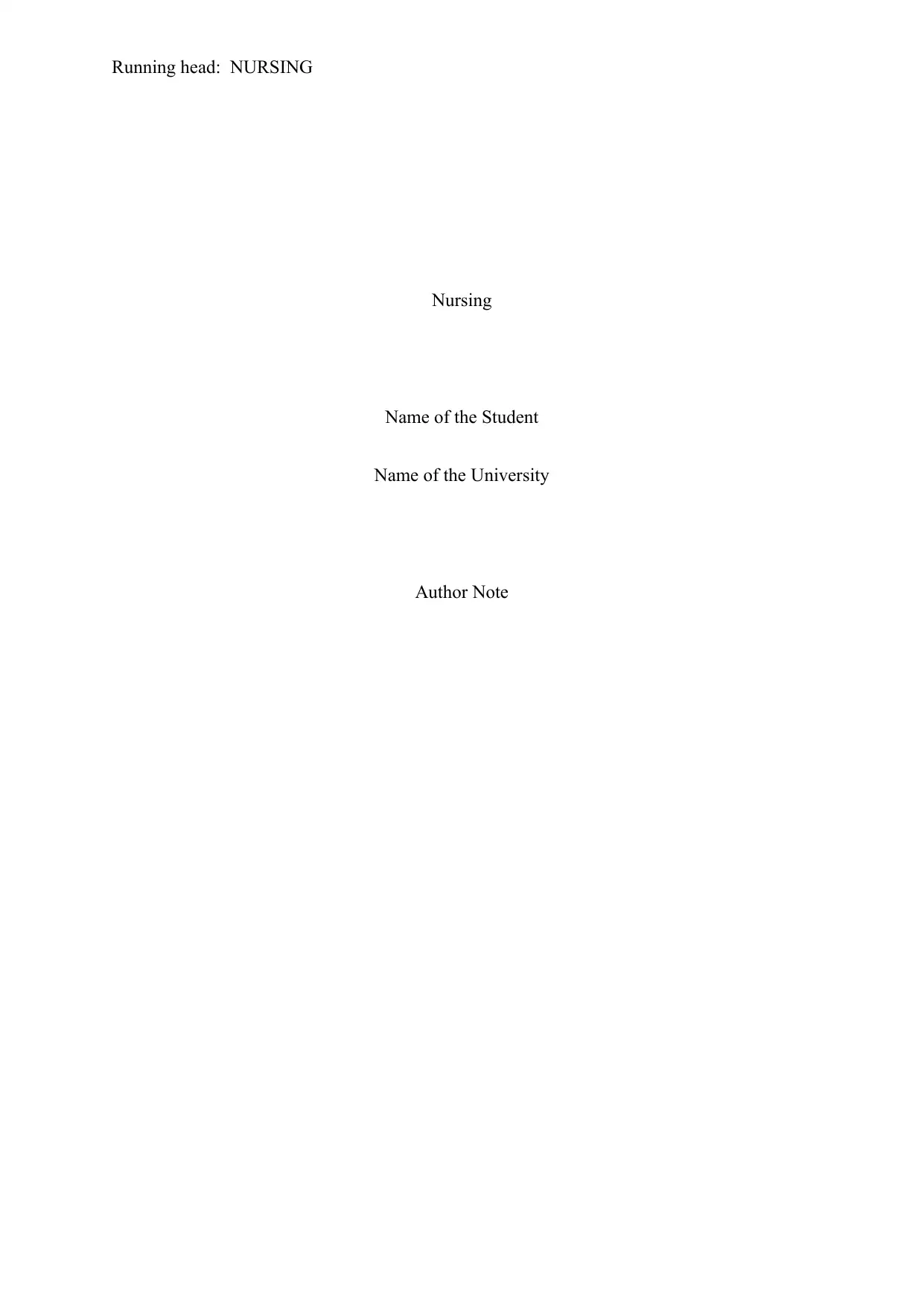
Running head: NURSING
Nursing
Name of the Student
Name of the University
Author Note
Nursing
Name of the Student
Name of the University
Author Note
Paraphrase This Document
Need a fresh take? Get an instant paraphrase of this document with our AI Paraphraser
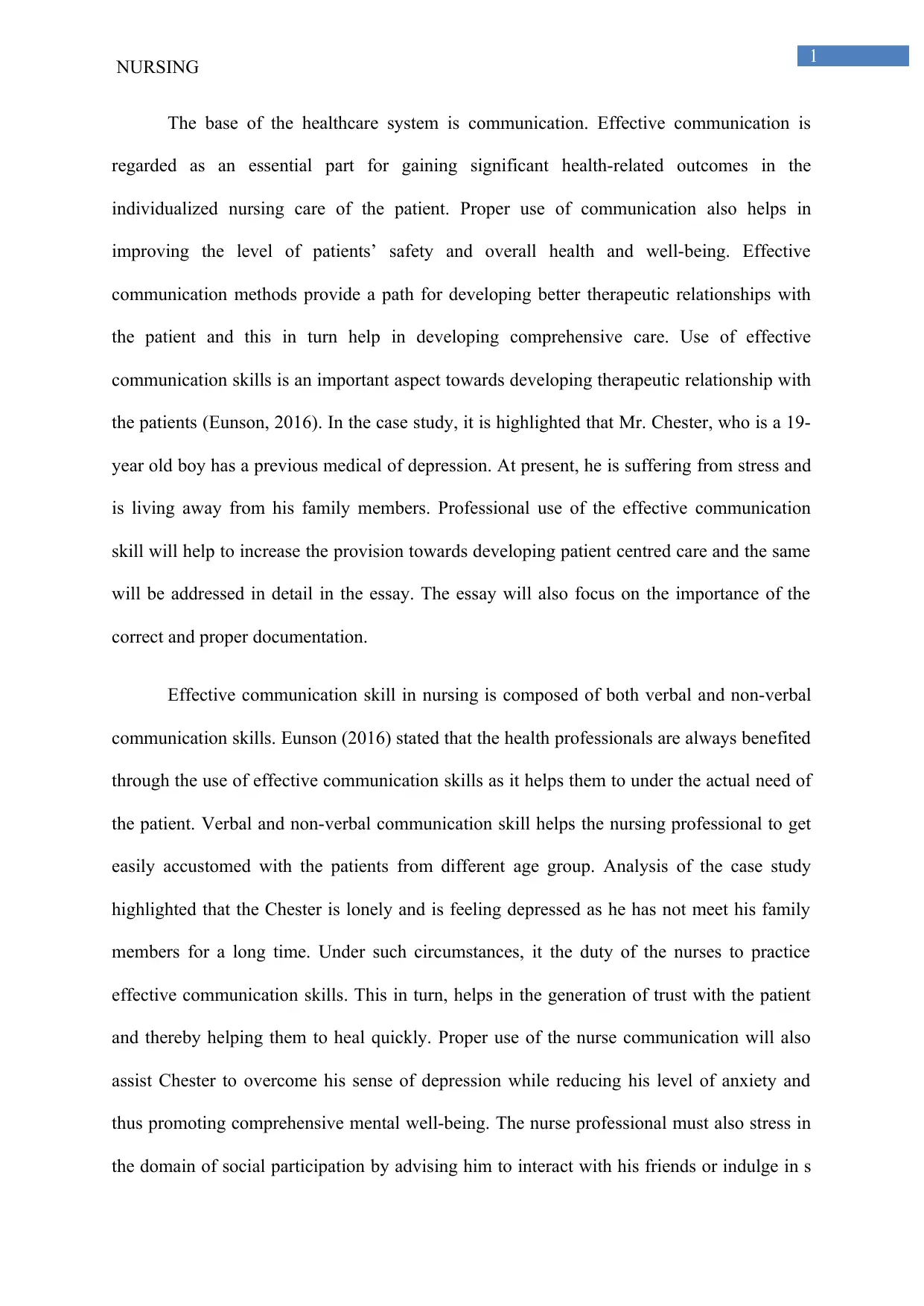
1
NURSING
The base of the healthcare system is communication. Effective communication is
regarded as an essential part for gaining significant health-related outcomes in the
individualized nursing care of the patient. Proper use of communication also helps in
improving the level of patients’ safety and overall health and well-being. Effective
communication methods provide a path for developing better therapeutic relationships with
the patient and this in turn help in developing comprehensive care. Use of effective
communication skills is an important aspect towards developing therapeutic relationship with
the patients (Eunson, 2016). In the case study, it is highlighted that Mr. Chester, who is a 19-
year old boy has a previous medical of depression. At present, he is suffering from stress and
is living away from his family members. Professional use of the effective communication
skill will help to increase the provision towards developing patient centred care and the same
will be addressed in detail in the essay. The essay will also focus on the importance of the
correct and proper documentation.
Effective communication skill in nursing is composed of both verbal and non-verbal
communication skills. Eunson (2016) stated that the health professionals are always benefited
through the use of effective communication skills as it helps them to under the actual need of
the patient. Verbal and non-verbal communication skill helps the nursing professional to get
easily accustomed with the patients from different age group. Analysis of the case study
highlighted that the Chester is lonely and is feeling depressed as he has not meet his family
members for a long time. Under such circumstances, it the duty of the nurses to practice
effective communication skills. This in turn, helps in the generation of trust with the patient
and thereby helping them to heal quickly. Proper use of the nurse communication will also
assist Chester to overcome his sense of depression while reducing his level of anxiety and
thus promoting comprehensive mental well-being. The nurse professional must also stress in
the domain of social participation by advising him to interact with his friends or indulge in s
NURSING
The base of the healthcare system is communication. Effective communication is
regarded as an essential part for gaining significant health-related outcomes in the
individualized nursing care of the patient. Proper use of communication also helps in
improving the level of patients’ safety and overall health and well-being. Effective
communication methods provide a path for developing better therapeutic relationships with
the patient and this in turn help in developing comprehensive care. Use of effective
communication skills is an important aspect towards developing therapeutic relationship with
the patients (Eunson, 2016). In the case study, it is highlighted that Mr. Chester, who is a 19-
year old boy has a previous medical of depression. At present, he is suffering from stress and
is living away from his family members. Professional use of the effective communication
skill will help to increase the provision towards developing patient centred care and the same
will be addressed in detail in the essay. The essay will also focus on the importance of the
correct and proper documentation.
Effective communication skill in nursing is composed of both verbal and non-verbal
communication skills. Eunson (2016) stated that the health professionals are always benefited
through the use of effective communication skills as it helps them to under the actual need of
the patient. Verbal and non-verbal communication skill helps the nursing professional to get
easily accustomed with the patients from different age group. Analysis of the case study
highlighted that the Chester is lonely and is feeling depressed as he has not meet his family
members for a long time. Under such circumstances, it the duty of the nurses to practice
effective communication skills. This in turn, helps in the generation of trust with the patient
and thereby helping them to heal quickly. Proper use of the nurse communication will also
assist Chester to overcome his sense of depression while reducing his level of anxiety and
thus promoting comprehensive mental well-being. The nurse professional must also stress in
the domain of social participation by advising him to interact with his friends or indulge in s
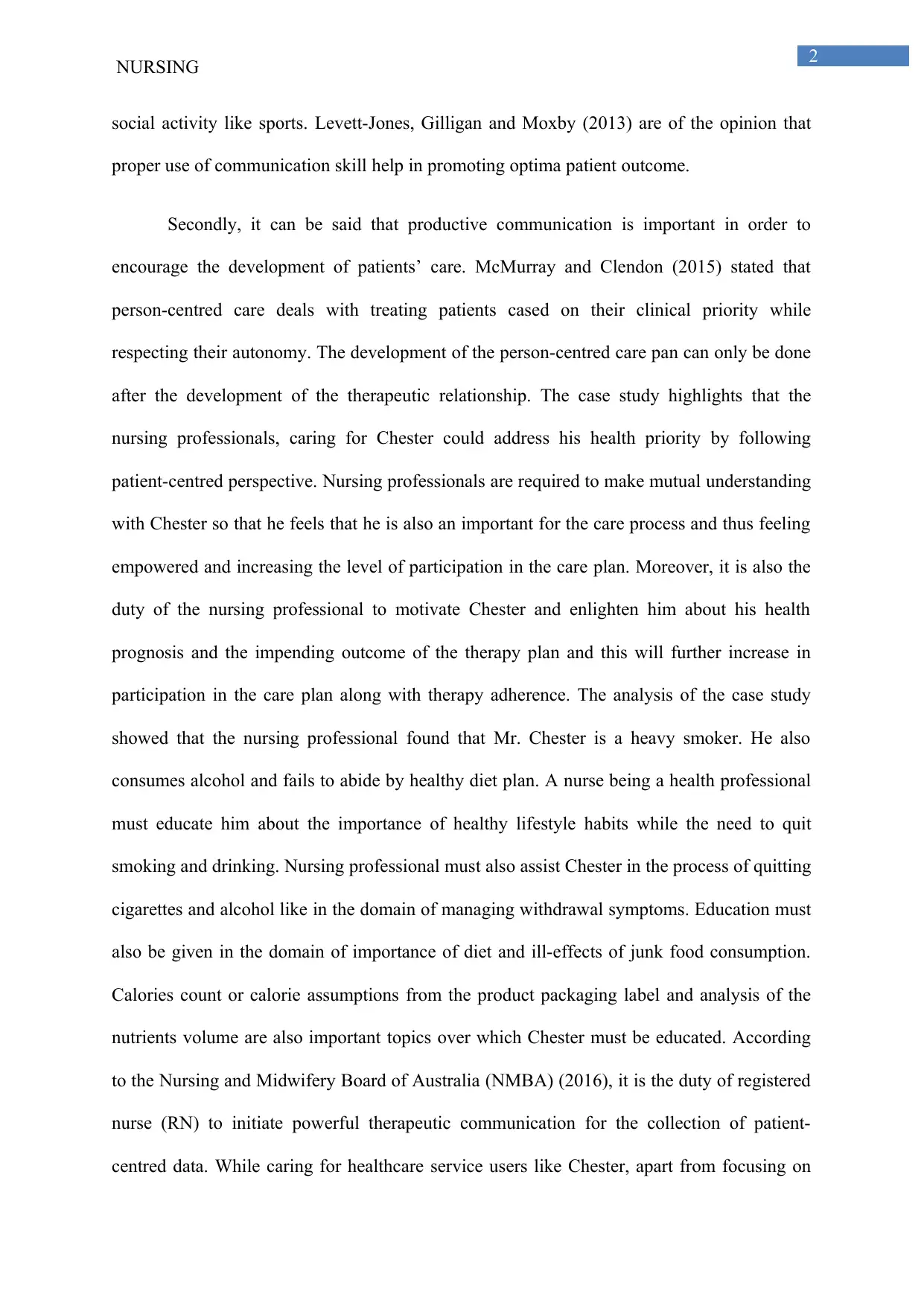
2
NURSING
social activity like sports. Levett-Jones, Gilligan and Moxby (2013) are of the opinion that
proper use of communication skill help in promoting optima patient outcome.
Secondly, it can be said that productive communication is important in order to
encourage the development of patients’ care. McMurray and Clendon (2015) stated that
person-centred care deals with treating patients cased on their clinical priority while
respecting their autonomy. The development of the person-centred care pan can only be done
after the development of the therapeutic relationship. The case study highlights that the
nursing professionals, caring for Chester could address his health priority by following
patient-centred perspective. Nursing professionals are required to make mutual understanding
with Chester so that he feels that he is also an important for the care process and thus feeling
empowered and increasing the level of participation in the care plan. Moreover, it is also the
duty of the nursing professional to motivate Chester and enlighten him about his health
prognosis and the impending outcome of the therapy plan and this will further increase in
participation in the care plan along with therapy adherence. The analysis of the case study
showed that the nursing professional found that Mr. Chester is a heavy smoker. He also
consumes alcohol and fails to abide by healthy diet plan. A nurse being a health professional
must educate him about the importance of healthy lifestyle habits while the need to quit
smoking and drinking. Nursing professional must also assist Chester in the process of quitting
cigarettes and alcohol like in the domain of managing withdrawal symptoms. Education must
also be given in the domain of importance of diet and ill-effects of junk food consumption.
Calories count or calorie assumptions from the product packaging label and analysis of the
nutrients volume are also important topics over which Chester must be educated. According
to the Nursing and Midwifery Board of Australia (NMBA) (2016), it is the duty of registered
nurse (RN) to initiate powerful therapeutic communication for the collection of patient-
centred data. While caring for healthcare service users like Chester, apart from focusing on
NURSING
social activity like sports. Levett-Jones, Gilligan and Moxby (2013) are of the opinion that
proper use of communication skill help in promoting optima patient outcome.
Secondly, it can be said that productive communication is important in order to
encourage the development of patients’ care. McMurray and Clendon (2015) stated that
person-centred care deals with treating patients cased on their clinical priority while
respecting their autonomy. The development of the person-centred care pan can only be done
after the development of the therapeutic relationship. The case study highlights that the
nursing professionals, caring for Chester could address his health priority by following
patient-centred perspective. Nursing professionals are required to make mutual understanding
with Chester so that he feels that he is also an important for the care process and thus feeling
empowered and increasing the level of participation in the care plan. Moreover, it is also the
duty of the nursing professional to motivate Chester and enlighten him about his health
prognosis and the impending outcome of the therapy plan and this will further increase in
participation in the care plan along with therapy adherence. The analysis of the case study
showed that the nursing professional found that Mr. Chester is a heavy smoker. He also
consumes alcohol and fails to abide by healthy diet plan. A nurse being a health professional
must educate him about the importance of healthy lifestyle habits while the need to quit
smoking and drinking. Nursing professional must also assist Chester in the process of quitting
cigarettes and alcohol like in the domain of managing withdrawal symptoms. Education must
also be given in the domain of importance of diet and ill-effects of junk food consumption.
Calories count or calorie assumptions from the product packaging label and analysis of the
nutrients volume are also important topics over which Chester must be educated. According
to the Nursing and Midwifery Board of Australia (NMBA) (2016), it is the duty of registered
nurse (RN) to initiate powerful therapeutic communication for the collection of patient-
centred data. While caring for healthcare service users like Chester, apart from focusing on
⊘ This is a preview!⊘
Do you want full access?
Subscribe today to unlock all pages.

Trusted by 1+ million students worldwide
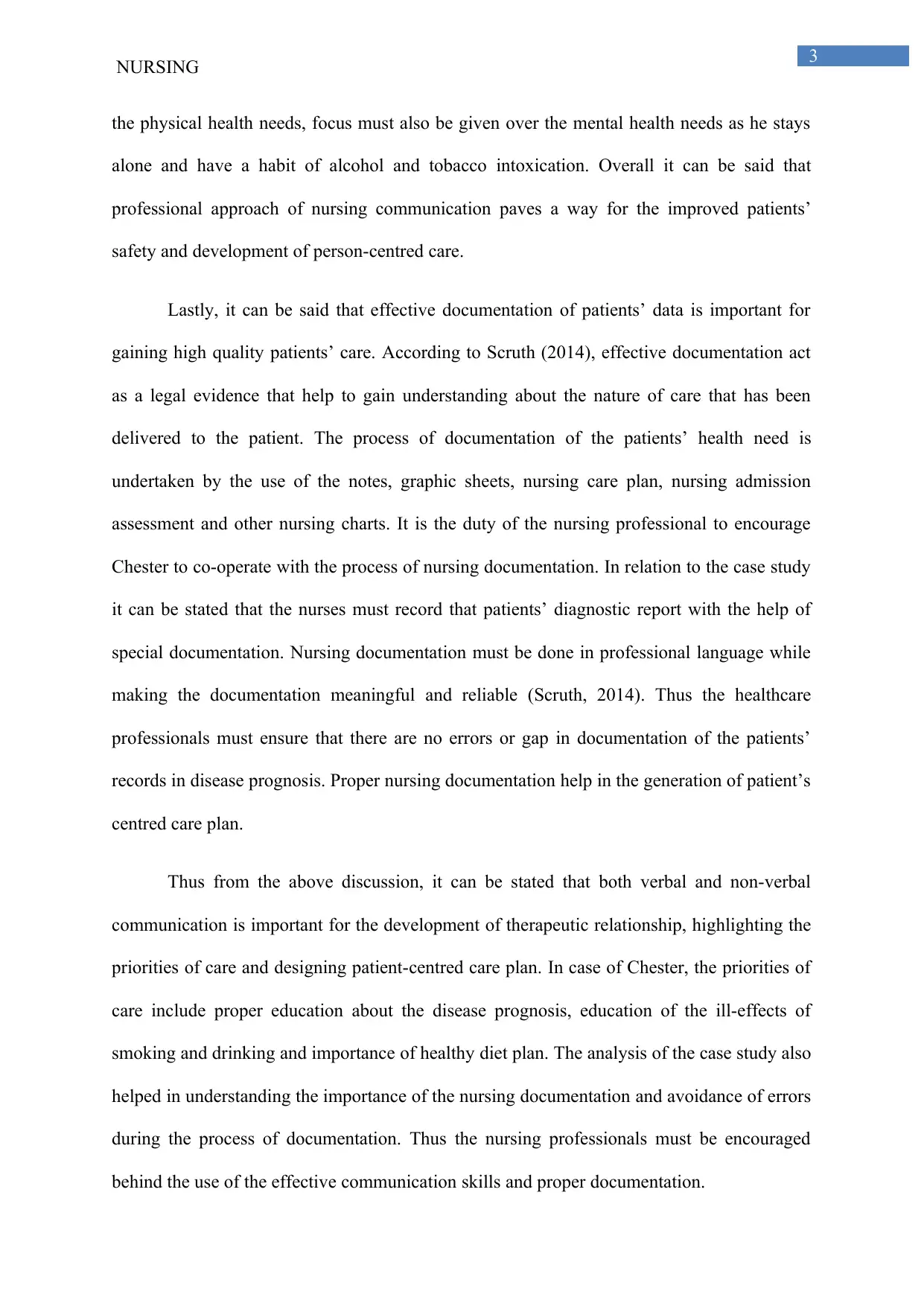
3
NURSING
the physical health needs, focus must also be given over the mental health needs as he stays
alone and have a habit of alcohol and tobacco intoxication. Overall it can be said that
professional approach of nursing communication paves a way for the improved patients’
safety and development of person-centred care.
Lastly, it can be said that effective documentation of patients’ data is important for
gaining high quality patients’ care. According to Scruth (2014), effective documentation act
as a legal evidence that help to gain understanding about the nature of care that has been
delivered to the patient. The process of documentation of the patients’ health need is
undertaken by the use of the notes, graphic sheets, nursing care plan, nursing admission
assessment and other nursing charts. It is the duty of the nursing professional to encourage
Chester to co-operate with the process of nursing documentation. In relation to the case study
it can be stated that the nurses must record that patients’ diagnostic report with the help of
special documentation. Nursing documentation must be done in professional language while
making the documentation meaningful and reliable (Scruth, 2014). Thus the healthcare
professionals must ensure that there are no errors or gap in documentation of the patients’
records in disease prognosis. Proper nursing documentation help in the generation of patient’s
centred care plan.
Thus from the above discussion, it can be stated that both verbal and non-verbal
communication is important for the development of therapeutic relationship, highlighting the
priorities of care and designing patient-centred care plan. In case of Chester, the priorities of
care include proper education about the disease prognosis, education of the ill-effects of
smoking and drinking and importance of healthy diet plan. The analysis of the case study also
helped in understanding the importance of the nursing documentation and avoidance of errors
during the process of documentation. Thus the nursing professionals must be encouraged
behind the use of the effective communication skills and proper documentation.
NURSING
the physical health needs, focus must also be given over the mental health needs as he stays
alone and have a habit of alcohol and tobacco intoxication. Overall it can be said that
professional approach of nursing communication paves a way for the improved patients’
safety and development of person-centred care.
Lastly, it can be said that effective documentation of patients’ data is important for
gaining high quality patients’ care. According to Scruth (2014), effective documentation act
as a legal evidence that help to gain understanding about the nature of care that has been
delivered to the patient. The process of documentation of the patients’ health need is
undertaken by the use of the notes, graphic sheets, nursing care plan, nursing admission
assessment and other nursing charts. It is the duty of the nursing professional to encourage
Chester to co-operate with the process of nursing documentation. In relation to the case study
it can be stated that the nurses must record that patients’ diagnostic report with the help of
special documentation. Nursing documentation must be done in professional language while
making the documentation meaningful and reliable (Scruth, 2014). Thus the healthcare
professionals must ensure that there are no errors or gap in documentation of the patients’
records in disease prognosis. Proper nursing documentation help in the generation of patient’s
centred care plan.
Thus from the above discussion, it can be stated that both verbal and non-verbal
communication is important for the development of therapeutic relationship, highlighting the
priorities of care and designing patient-centred care plan. In case of Chester, the priorities of
care include proper education about the disease prognosis, education of the ill-effects of
smoking and drinking and importance of healthy diet plan. The analysis of the case study also
helped in understanding the importance of the nursing documentation and avoidance of errors
during the process of documentation. Thus the nursing professionals must be encouraged
behind the use of the effective communication skills and proper documentation.
Paraphrase This Document
Need a fresh take? Get an instant paraphrase of this document with our AI Paraphraser
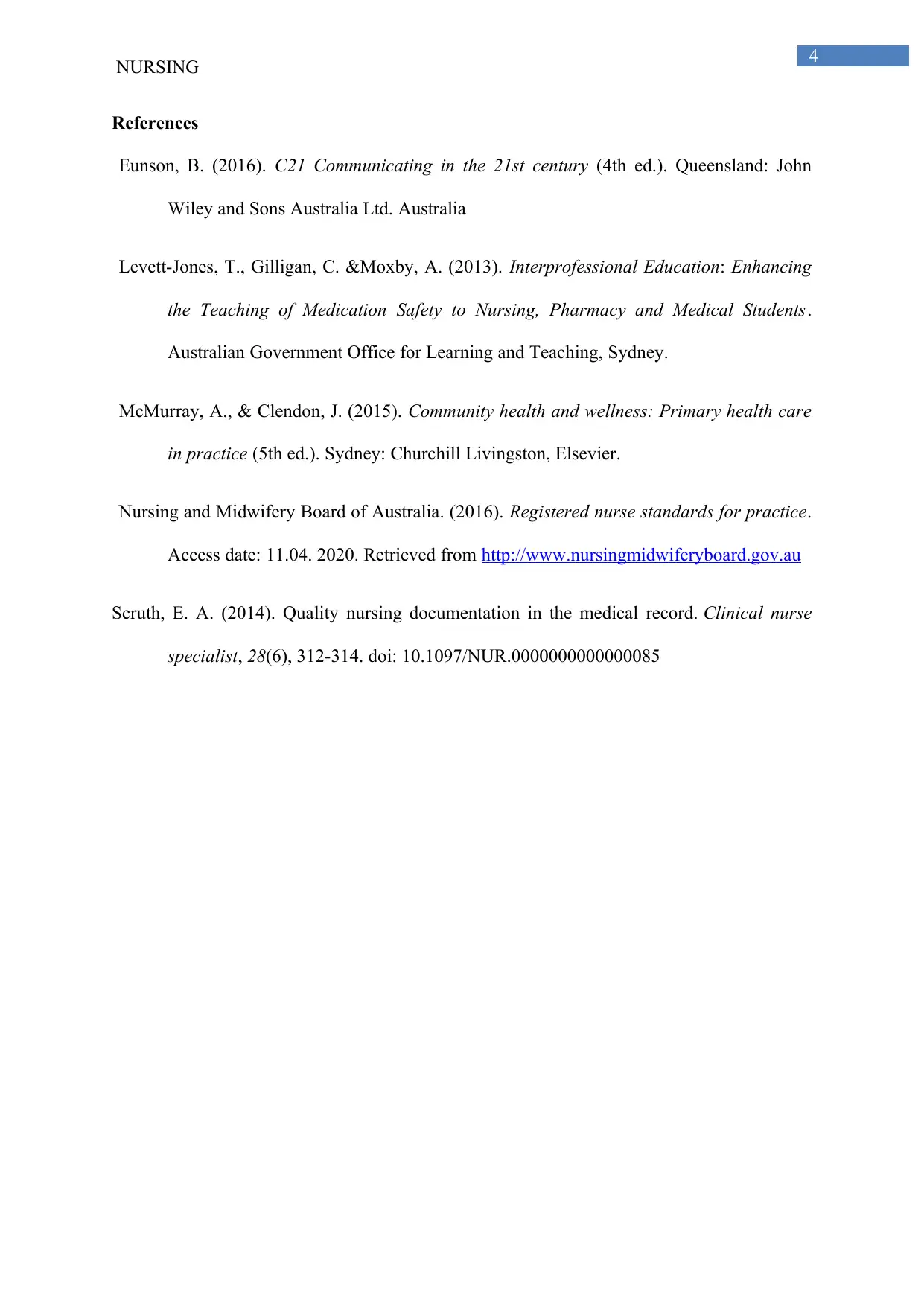
4
NURSING
References
Eunson, B. (2016). C21 Communicating in the 21st century (4th ed.). Queensland: John
Wiley and Sons Australia Ltd. Australia
Levett-Jones, T., Gilligan, C. &Moxby, A. (2013). Interprofessional Education: Enhancing
the Teaching of Medication Safety to Nursing, Pharmacy and Medical Students.
Australian Government Office for Learning and Teaching, Sydney.
McMurray, A., & Clendon, J. (2015). Community health and wellness: Primary health care
in practice (5th ed.). Sydney: Churchill Livingston, Elsevier.
Nursing and Midwifery Board of Australia. (2016). Registered nurse standards for practice.
Access date: 11.04. 2020. Retrieved from http://www.nursingmidwiferyboard.gov.au
Scruth, E. A. (2014). Quality nursing documentation in the medical record. Clinical nurse
specialist, 28(6), 312-314. doi: 10.1097/NUR.0000000000000085
NURSING
References
Eunson, B. (2016). C21 Communicating in the 21st century (4th ed.). Queensland: John
Wiley and Sons Australia Ltd. Australia
Levett-Jones, T., Gilligan, C. &Moxby, A. (2013). Interprofessional Education: Enhancing
the Teaching of Medication Safety to Nursing, Pharmacy and Medical Students.
Australian Government Office for Learning and Teaching, Sydney.
McMurray, A., & Clendon, J. (2015). Community health and wellness: Primary health care
in practice (5th ed.). Sydney: Churchill Livingston, Elsevier.
Nursing and Midwifery Board of Australia. (2016). Registered nurse standards for practice.
Access date: 11.04. 2020. Retrieved from http://www.nursingmidwiferyboard.gov.au
Scruth, E. A. (2014). Quality nursing documentation in the medical record. Clinical nurse
specialist, 28(6), 312-314. doi: 10.1097/NUR.0000000000000085
1 out of 5
Related Documents
Your All-in-One AI-Powered Toolkit for Academic Success.
+13062052269
info@desklib.com
Available 24*7 on WhatsApp / Email
![[object Object]](/_next/static/media/star-bottom.7253800d.svg)
Unlock your academic potential
Copyright © 2020–2025 A2Z Services. All Rights Reserved. Developed and managed by ZUCOL.





